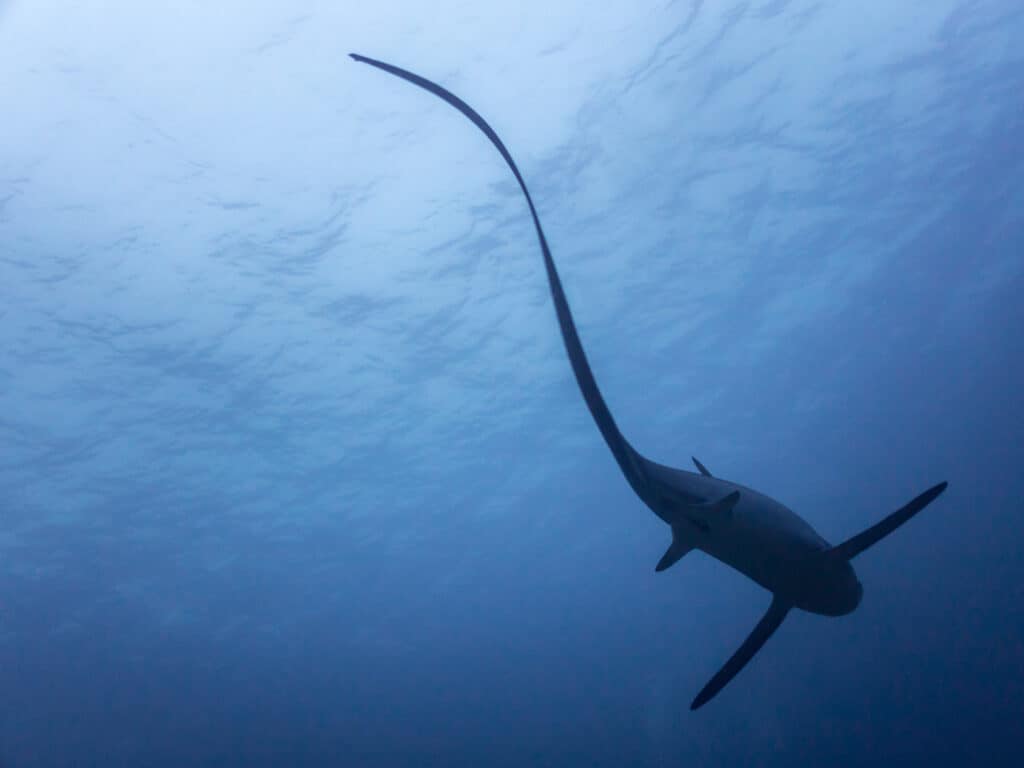Thresher Shark
Thresher Sharks have a distinctive, thresher-like tail.
Advertisement
Thresher Shark Scientific Classification
Read our Complete Guide to Classification of Animals.
Thresher Shark Conservation Status
Thresher Shark Facts
Thresher Shark Physical Characteristics
- Color
- Grey
- White
- Skin Type
- Scales
- Lifespan
- 19 to 50 years
- Weight
- 500 to 775 pounds
- Length
- Up to 20 ft long
- Age of Sexual Maturity
- Three to Six Years
- Venomous
- No
- Aggression
- Low
View all of the Thresher Shark images!
Thresher sharks are a larger group of sharks found in all temperate and tropical oceans worldwide. This family contains a single genus and three modern-day species. Plus, all species in this family are vulnerable to extinction.
5 Thresher Shark Facts
- Tail weapon: These sharks use their tail to herd fish, stun them, and kill them. While their tails are often very aesthetically pleasing, they are not just there for looks.
- Non-threatening: Despite their unique hunting strategy, these sharks are non-threatening to humans. Very few shark bites are reported from the sharks in this family.
- Jumping skills: Thresher sharks can jump extremely high. They jump higher than almost any other sea animal.
- Other potential species: While we know three species still exist, other species may also do. For instance, a potential fourth species was located through DNA evidence but not documented otherwise.
- Low aggression: Despite being sharks (and somewhat scary-looking), these sharks are not very aggressive. This trait makes them prone to over-fishing.
Thresher Classification and Scientific Name
Technically, Thresher Sharks are a particular family of sharks. However, they can also be used to describe a genus, as only one genus exists in this family. Therefore, while technically a family, you may also read references to the “genus” of thresher sharks.
This family belongs to the order Lamniformes, which are also known as mackerel sharks. They include some famous shark species, such as the great white and goblin sharks. Members of this order have eyes without nictitating membranes, a mouth that extends behind their eyes, and two dorsal fins.
Types of Thresher Shark: The 3 Different Species
Currently, three species are widely accepted in this family. While other species may exist, they are not accepted by all experts. Therefore, we will only be discussing the three widely accepted species.
The pelagic thresher (Alopias pelagicus) is the smallest of the thresher sharks. It lives in the subtropical waters of the Indian and Pacific Oceans, which usually live far from the shore. In 2019, this species was listed as endangered.
The bigeye thresher (Alopias superciliosus) is considered vulnerable to extinction due to its decreasing population. It has a very large range and is found worldwide. Its common name comes from its extremely large eyes, adapted to hunt in low-light conditions.
Finally, the common thresher (Alopias vulpinus) is the largest. It can reach up to 20 feet long. This species prefers slightly cooler temperatures than the other two, though it can be found worldwide. The common thresher is also considered vulnerable, as it does not reproduce quickly.
Thresher Shark Appearance
One of the most distinguished features of a thresher shark is its long tail. This tail is utilized to stun and kill prey, which the shark eats. Typically, this shark consumes small to medium schooling fish. Therefore, it swings its tail towards one of these schools to capture prey.
Compared to most sharks, this species has a relatively small mouth. Its teeth size varies between species, though some have relatively small teeth.
This family of sharks varies in size depending on the exact species. The largest thresher can reach up to 20 ft and weigh over 1,000 pounds. However, the pelagic thresher can only reach 10 feet.
Typically, these sharks are very slender. Their dorsal fin is small compared to other sharks and extremely aerodynamic. Their coloration varies, and some may have stripes or other markings. Common threshers are usually dark green, pelagic threshers are blue, and bigeye threshers are brown.

©HikeAndShoot/Shutterstock.com
Thresher Shark Distribution, Population, and Habitat
The thresher shark has a huge range. You can find these sharks just about anywhere outside of Arctic waters, which are too cold to survive. They usually prefer the open ocean. However, some species may wander close to the shore occasionally. Common threshers are the most common species to wander towards the continental shelf.
In warmer waters, bigeye and pelagic threshers are more common. However, common threshers prefer slightly cooler waters.
Currently, experts believe that 1,600 ft deep is this family’s limit. Still, video evidence has emerged in a few places putting thresher sharks lower than this. Therefore, many are currently re-thinking how deep these sharks can go.
Furthermore, thresher sharks are commonly seen outside of their range. For instance, bigeye was spotted in the Mediterranean. We do not know as much about these sharks’ ranges as we’d like to think.
Thresher Shark Predators and Prey
These sharks do not have many predators, as they are typically the top carnivore. However, juvenile sharks are more likely to be eaten by other sharks.
What do Thresher Sharks eat?
Thresher sharks eat mostly school fish that stay in the open water. These fish include bluefish, tuna, and mackerel. However, sometimes they wander into coastal waters, where they eat squid and cuttlefish. With that said, they aren’t very picky, so they will usually eat whatever they can get their hands on.
For instance, these thresher sharks also eat seabirds and crustaceans.
These sharks stun their prey with their long tail. Therefore, they will eat anything that they can stun with their thresher tail.
What eats Thresher sharks?
Many predators do not eat thresher sharks. However, younger sharks may be eaten by larger sharks. Therefore, younger sharks are more likely to be eaten than larger ones. As the sharks get larger, their odds of being eaten are lowered.
Thresher Sharks Reproduction and Lifespan
According to researchers, thresher sharks do not have any breeding season. Instead, they breed throughout the year. As live-bearing sharks, fertilization and embryonic development occur internally.
The pup sharks are born unusually large, measuring up to 59 inches. Usually, their litters are small at only two to four. Once the young fish run through their yolk sac, they eat their mom’s unfertilized eggs, called oophagy.
Despite being born large, these sharks take a while to mature. Typically, it takes between seven to 13 years for females to mature. Males mature around eight to 14 years. However, because sharks mature based on their size, it may take them up to 20 years to mature if food isn’t readily available.
Thresher Sharks in Fishing and Cooking
These sharks are not regularly used for cooking. Unlike other sharks, their fins are not regularly utilized for shark fin soup, which protects them somewhat from poaching. However, they remain popular game fish in the United States and South Africa.
For instance, the common thresher shark is extremely popular in Baja, Mexico.
View all 133 animals that start with TThresher Shark FAQs (Frequently Asked Questions)
Where are Thresher Sharks found?
Thresher sharks are found in all temperate and tropical oceans. The exact subspecies do vary, of course. However, thresher sharks are very common in every ocean that isn’t too cold. Furthermore, these sharks move quite a bit, increasing their range significantly.
How aggressive are Thresher Sharks?
Thresher sharks are quite shy and don’t like being around people. They only target small animals, as they stun them with their tail. Therefore, they do not target people, as they are too large for this to work.
However, these sharks can get a bit large. Therefore, they are not completely harmless. They are still wild animals, so care needs to be taken.
Why are Thresher Sharks tails so long?
Thresher sharks use their massive tail to hit and stun fish, which allows them to become easy prey. They will use their lengthy tails to swat sardines from schools, which researchers discovered by taking underwater videos. Therefore, their long tails are essential to their survival.
Thank you for reading! Have some feedback for us? Contact the AZ Animals editorial team.
Sources
- Oregon State University, Available here: https://seagrant.oregonstate.edu/visitor-center/sharks/common-thresher
- Wikipedia, Available here: https://en.wikipedia.org/wiki/Thresher_shark
- Marine Bio, Available here: https://www.marinebio.org/species/thresher-sharks/alopias-vulpinus/
- NOAA Fisheries, Available here: https://www.fisheries.noaa.gov/species/atlantic-common-thresher-shark

















